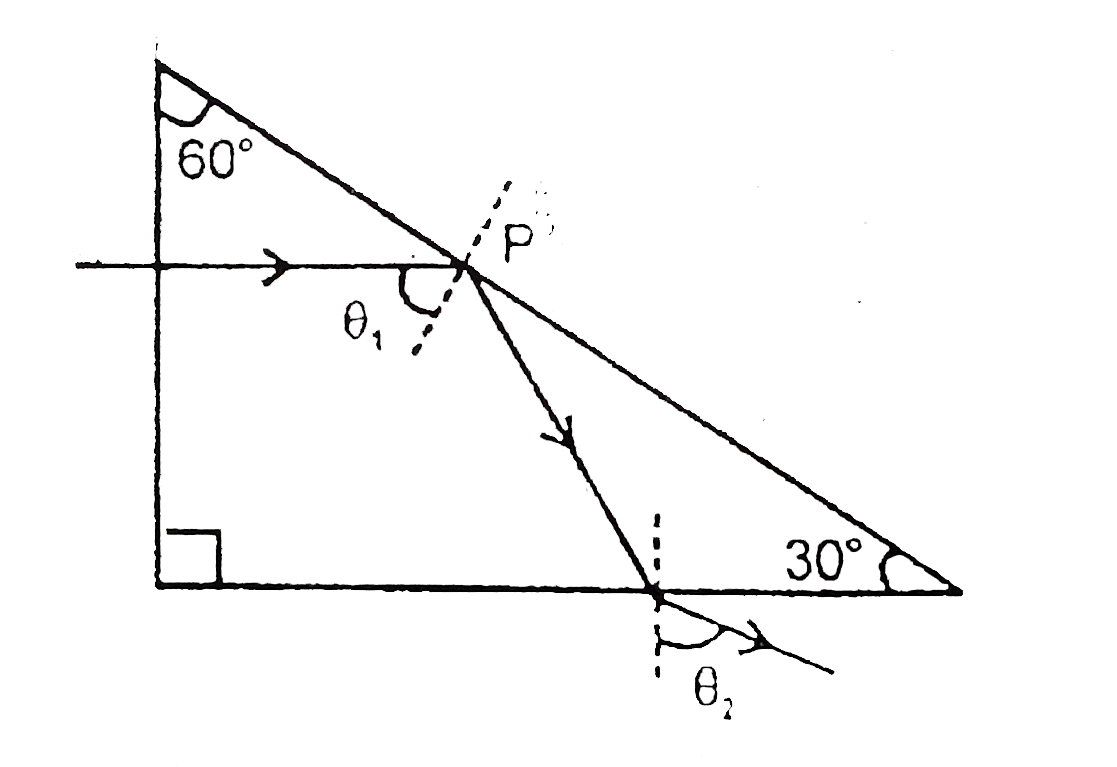A ray of light incident normally on a refracting surface of the prism is totally reflected from the other refracting surface. If the prism is immersed in water how will the ray act? Refractive index of glass = 1.5, refractive index of water = 1.33.
As the ray of light is incident on a face of the prism normally, so it goes straight through the surface. The ray is incident on the second refracting face and is totally reflected. So the angle of incidence of the ray at the second face is greater than the critical angle (θc).
sinθc=1aμg=11.5=0.667
=sin41.8∘
∴ θc=41.8∘
Now, if the prism is immersed in water, refractive index of glass with respect to water is,
wμg=aμgaμw=1.51.33=1.128
In this case if the critical angle is θc, then
sinθ.c=1wμg=11.128=0.8865
=sin62.44∘
or, θ.c=62.44∘
So the angle of incidence of the ray at the second face (41.8∘) is less than the critical angle (62.44∘). Hence, instead of being totally reflected from the second face, the ray is refracted through it.
Topper's Solved these Questions
- REFRACTION OF LIGHTBOOK - CHHAYA PUBLICATIONCHAPTER - REFRACTION OF LIGHTEXERCISE - HIGHER ORDER THINKING SKILL (HOTS QUESTION)
25 Videos
- REFRACTION OF LIGHTBOOK - CHHAYA PUBLICATIONCHAPTER - REFRACTION OF LIGHTEXERCISE - SECTION RELATED QUESTION
18 Videos
- REFLECTION OF LIGHTBOOK - CHHAYA PUBLICATIONCHAPTER - REFLECTION OF LIGHTEXERCISE - INTEGER ANSWER TYPE
3 Videos
- SEMICONDUCTORS AND ELECTRONICS BOOK - CHHAYA PUBLICATIONCHAPTER - SEMICONDUCTORS AND ELECTRONICS EXERCISE - CBSE SCANNER
31 Videos
Similar Questions
When a ray of light is incident normally on one refracting surface of an equilateral prism (Refractive index of the material of the prism =1.5)
View SolutionWhen a ray of light is incident normally on one refracting surface of an equilateral prism (Refractive index of the material of the prism =1.5
View Solution
Knowledge Check
When a ray of light is incident normally on one refracting surface of an equilateral prism (Refractive index of the material of the prism =1.5
AEmerging ray is deviated by 30BEmerging ray is deviated by 45∘CEmerging ray just grazes the second refracting surfaceDThe ray undergoes total internal reflection at the second refracting surfaceWhen a ray of light is incident normally on one refracting surface of an equilateral prism of refractive index 1.5, then
Athe ray undergoes total internal reflection at the second refracting surface of prismBemergent ray is deviated by 30∘Cemergent ray is deviated by 60∘Demergent ray just grazes the second refracting surface of the prismA ray of light incident at an angle θ on a refracting face of a prism emerges from the other face normally. If the angle of prism is 5∘ and the prism is made of a material of refractive index 1.5, the angle of incidence is
A7.5∘B5∘C15∘D2.5∘
A ray of light incident normally on the first face of a glass prism of refractive index 1.6 just emerges from the other face. Find the angle of the prism.
View SolutionA ray of light is incident normally on one of the refracting surfaces of a prism of refracting angle A,. The emergent ray grazes the other refracting surface. Find the refractive index of the material ofprism.
View Solution
A ray of light is incident normally on one face of a prism as shown in figure. The refractive index of the material of the prism is 53 and the prism is immersed in water of refractive index 43, then
View SolutionA ray of light is incident normally on one of the refracting surfaces of a prism of refracting angle A,. The emergent ray grazes the other refracting surface. Find the refractive index of the material ofprism.
View Solution
A ray of light is incident normally on one face of a prism as shown in figure. The refractive index of the material of the prism is 53 and the prism is immersed in water of refractive index 43, then
View Solution
